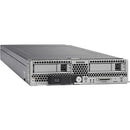Description
Cisco B200 M4 Blade Server – Dual Xeon E5-2630 v4, 128 GB RAM, 12Gb/s SAS Controller
The Cisco B200 M4 Blade Server is a high-performance, scalable compute node designed for Cisco UCS B-Series blades. Built to integrate seamlessly into a Cisco UCS environment, this blade delivers enterprise-grade processing power, substantial memory capacity, and fast storage connectivity within a compact, modular chassis. Ideal for virtualization, database workloads, and mission-critical applications, the B200 M4 is optimized for simplified management, lower total cost of ownership, and rapid deployment. It combines two Intel Xeon E5-2630 v4 processors at 2.20 GHz with ample RAM and a fast SAS/SATA storage controller to deliver consistent, predictable performance under heavy workloads. With Cisco UCS Manager integration and converged networking, administrators can provision, monitor, and scale resources with policy-based automation, improving agility while maintaining stringent reliability and security standards.
- Robust dual‑processor performance for demanding workloads: Equipped with two Intel Xeon E5-2630 v4 processors at 2.20 GHz, the B200 M4 blade delivers strong multi‑threaded performance across virtualization, databases, and enterprise apps. With a total of up to 20 cores and 40 threads in typical configurations, this blade can handle dense virtualized environments, scale-out deployments, and compute-intensive tasks with reliability and responsiveness.
- Generous memory for virtualization and in‑memory workloads: The blade includes 128 GB of RAM, enabling efficient consolidation of virtual machines, large in‑memory databases, and real‑time analytics. The substantial memory headroom supports memory‑bound applications, large caches, and rapid data access, reducing bottlenecks and improving overall system throughput.
- Fast storage connectivity with 12Gb/s SAS/SATA controller: A high‑speed storage controller supports 12Gb/s SAS and Serial ATA interfaces, enabling flexible storage configurations, quick I/O, and scalable capacity. This enables rapid data access for both transactional workloads and data-intensive applications, while remaining adaptable to evolving storage architectures.
- Integrated Cisco UCS management for streamlined operations: The B200 M4 is designed to work within the Cisco UCS ecosystem, featuring integration with Cisco UCS Manager for policy‑driven provisioning, centralized monitoring, firmware lifecycle management, and simplified day‑to‑day operations. This reduces manual configuration, accelerates deployment, and provides end‑to‑end visibility across compute, network, and storage resources.
- Modular, chassis-friendly design for easy deployment and reliability: As a blade server in the Cisco UCS B‑Series, the B200 M4 is built for blade chassis deployment with redundant, hot‑swappable components, scalable networking options, and centralized management. This design supports rapid service deployment, simplified cabling, and high availability within a converged infrastructure, delivering a lower total cost of ownership over time.
Technical Details of Cisco B200 M4 Blade Server
- Processors: 2 x Intel Xeon E5-2630 v4 @ 2.20 GHz (10 cores per CPU, 20 threads total) for robust multi‑threaded performance across virtualized and enterprise workloads.
- Memory: 128 GB RAM integrated into the blade, supporting virtualization, databases, and memory‑intensive applications with sufficient headroom for growth.
- Storage Controller: 12Gb/s SAS, Serial ATA (SATA) controller enabling high‑speed data movement and flexible storage configurations for fast I/O and scalable capacity.
- Form Factor / Deployment: Cisco UCS B-Series blade server designed to slot into a compatible Cisco UCS chassis, enabling converged compute, networking, and storage access managed through UCS Manager.
- Networking / Expansion: Converged networking integration within the Cisco UCS framework, with options for additional NICs, mezzanine cards, and PCIe expansion to meet diverse connectivity needs in virtualized and traditional workloads.
- Management: Optimized for Cisco UCS Manager, providing policy‑driven provisioning, firmware control, health monitoring, and centralized lifecycle management across the blade and chassis environment.
How to install Cisco B200 M4 Blade Server
Step 1: Prepare the Cisco UCS chassis and ensure power, cooling, and network infrastructure are ready for blade insertion. Verify compatibility with the UCS fabric and chassis SLAs before proceeding.
Step 2: Power down the chassis and remove the desired blade bay cover. Align the Cisco B200 M4 blade with the blade slot, guiding connectors to the midplane to ensure proper seating.
Step 3: Slide the blade into the chassis until it is fully seated, then secure it with the blade latch. Attach any required mezzanine cards or PCIe expansion devices as specified for your workload requirements.
Step 4: Connect required network cables and storage interfaces to the blade’s mezzanine NICs or adapters, ensuring wiring aligns with your UCS policy and fabric interconnect configuration.
Step 5: Power on the chassis and access Cisco UCS Manager to create or attach a service profile for the B200 M4 blade. Apply the appropriate BIOS, firmware, and hardware policies, then verify health and readiness through UCS Manager dashboards.
Step 6: Initialize the operating system or virtualization platform as you would on any blade server, while ensuring firmware levels, drivers, and integrations are up to date for optimal performance and security.
Frequently asked questions
- Q: What workloads is the Cisco B200 M4 best suited for? A: The B200 M4 excels in virtualization, consolidating multiple workloads onto fewer physical servers, database and analytics applications, and enterprise services that require reliable, scalable compute with robust memory and fast storage access within a converged Cisco UCS environment.
- Q: Is the B200 M4 compatible with Cisco UCS Manager? A: Yes. The blade is designed to operate within the Cisco UCS Manager ecosystem, enabling policy‑driven provisioning, centralized lifecycle management, and streamlined monitoring across compute, network, and storage resources.
- Q: How much memory does this blade support? A: The configuration described includes 128 GB of RAM, suitable for dense virtualization and memory‑intensive applications. Depending on chassis capabilities and options, memory capacity can vary with different configurations.
- Q: What storage interfaces are available? A: The blade includes a 12Gb/s SAS/SATA storage controller to support high‑speed data transfer and flexible storage configurations, enabling rapid data access and scalable capacity as needs grow.
- Q: How do I keep the blade firmware up to date? A: Use Cisco UCS Manager to manage firmware with policy‑driven upgrades, or follow Cisco's recommended firmware lifecycle management practices to ensure compatibility across the UCS fabric and maintain security and performance.
Customer reviews
Showing - Of Reviews


